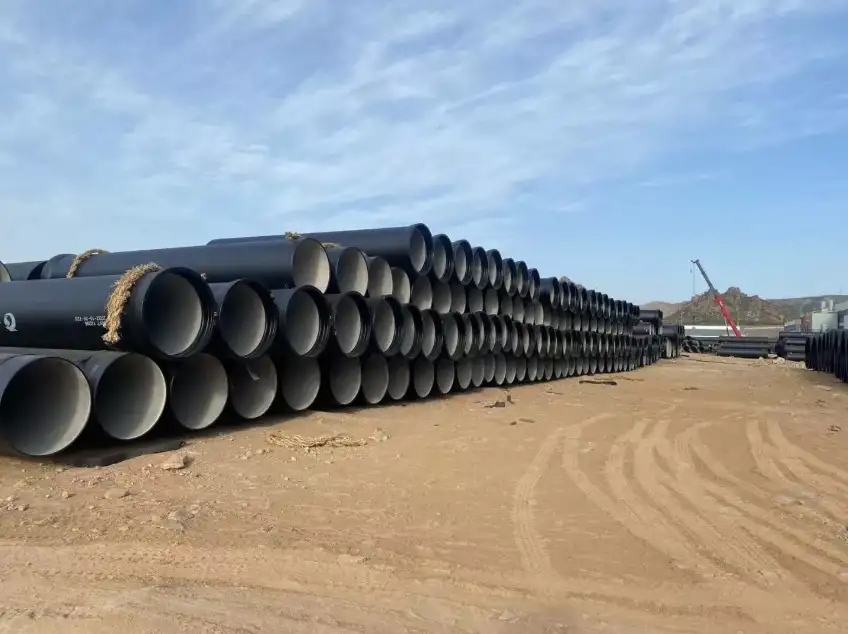In hydraulic engineering, the “C value” refers to the Hazen–Williams roughness coefficient. This dimensionless number is widely used to estimate friction losses (head loss) in water flow calculations, particularly in the Hazen–Williams formula. The C value indicates the efficiency with which water flows through a pipe – a higher value denotes a smoother interior surface, leading to lower friction losses.

Ductile Iron Pipes and Their C Value
Typical Ranges and Influencing Factors
For ductile iron pipes, the C value depends on factors such as:
-
Internal Lining: Many ductile iron pipes are lined internally with a cement mortar or epoxy coating. A smooth, new cement mortar lining can increase the C value.
-
Aging and Wear: With time, corrosion, deposition, or mechanical wear may reduce the effective C value.
-
Manufacturing Quality: The quality of the casting and nodulizing process can affect the intrinsic roughness of the pipe’s interior surface.
Typical Ranges:
-
New, Unlined Ductile Iron Pipes:
For a new ductile iron pipe without additional lining, the C value is often taken as approximately 130. -
Cement Mortar–Lined Ductile Iron Pipes:
When ductile iron pipes are lined with a high-quality cement mortar, they may exhibit a slightly higher C value, often in the range of 130 to 140 (some sources even quote values around 140–150 for very smooth, new linings).
These typical values are based on guidelines from various water supply and hydraulic engineering standards. In practice, engineers select a C value within this range based on the expected pipe age, maintenance history, and specific project requirements.
Comparison Table: Ductile Iron Pipe C Value
Below is a table summarizing typical C value ranges for ductile iron pipes under different conditions:
| Pipe Type | Typical C Value Range | Notes |
|---|---|---|
| New, Unlined Ductile Iron Pipe | 125 – 130 | Standard roughness of freshly cast ductile iron without lining. |
| New Cement Mortar–Lined Ductile Iron Pipe | 130 – 140 | Smooth internal lining leads to reduced friction losses. |
| Aged/Well-Used Ductile Iron Pipe (Unlined) | 120 – 125 | Surface roughness increases over time due to wear and deposits. |
| Aged Cement Mortar–Lined Ductile Iron Pipe | 125 – 135 | Some decline in smoothness may occur as the lining deteriorates. |
Note: These ranges are approximate. Actual values may vary with specific pipe conditions, regional practices, and the exact composition of the lining or alloy.
How the C Value Impacts Hydraulic Calculations
When using the Hazen–Williams equation, the C value directly influences the estimated head loss due to friction along the pipe. For example, higher C values (indicating smoother pipes) yield lower calculated head losses, which can result in more efficient water transmission. Selecting the appropriate value is critical for system design, ensuring that pumps and other hydraulic components are correctly sized.
Hydraulic design example:
If you are comparing two systems – one using new cement-mortar-lined ductile iron pipes with a C value of 135 and another using aged unlined pipes with a C value of 120 – the system with the higher C value will have lower friction loss. This can influence decisions on pipe sizing, pumping energy, and overall infrastructure cost.
The C value (Hazen–Williams coefficient) is a key parameter in hydraulic design that represents the interior smoothness of a pipe. For ductile iron pipes, typical C values range from about 125–130 for new, unlined pipes to approximately 130–140 (or sometimes even up to 150) for new cement mortar–lined pipes. Over time, the effective C value may decrease due to aging and wear.
Understanding these values is essential for engineers and project planners to accurately model friction losses, size equipment appropriately, and ensure efficient, cost-effective water distribution and other fluid transport systems.

